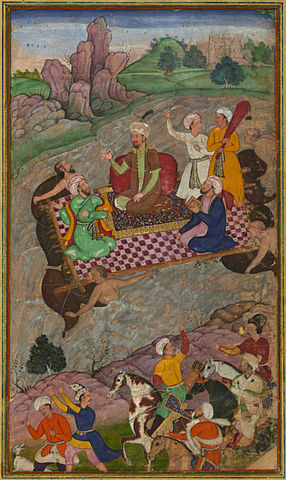 |
This is a file from the Wikimedia Commons. Information from its description page there is shown below.
Commons is a freely licensed media file repository. You can help.
|
Summary
| Description |
English: Illustrations from the Manuscript of Baburnama (Memoirs of Babur) - Late 16th CenturyBāburnāma is the memoirs of Ẓahīr ud-Dīn Muḥammad Bābur (1483-1530), founder of the Mughal Empire and a great-great-great-grandson of Timur. It is an autobiographical work, originally written in the Chagatai language, known to Babur as "Turki" (meaning Turkic), the spoken language of the Andijan-Timurids. Because of Babur's cultural origin, his prose is highly Persianized in its sentence structure, morphology, and vocabulary,and also contains many phrases and smaller poems in Persian. During Emperor Akbar's reign, the work was completely translated to Persian by a Mughal courtier, Abdul Rahīm, in AH (Hijri) 998 (1589-90). These Paintings, being a fragment of a dispersed copy, was executed most probably in the late 10th AH /16th CE century. It contains 30 mostly full-page miniatures in fine Mughal style by at least two different artists. Another major fragment of this work (57 folios) is in the State Museum of Eastern Cultures, Moscow.
|
| Date |
Late 16th Century |
| Source |
http://art.thewalters.org/detail/19845/babur-riding-a-raft-from-kunar-back-to-atar/
|
| Author |
- Ẓahīr ud-Dīn Muḥammad Bābur (1483-1530)
- It contains 30 mostly full-page miniatures in fine Mughal style by at least two different artists.
|
Licensing
This is a faithful photographic reproduction of an original two-dimensional work of art. The work of art itself is in the public domain for the following reason:
| Public domainPublic domainfalsefalse |
 |
This image (or other media file) is in the public domain because its copyright has expired.
This applies to Australia, the European Union and those countries with a copyright term of life of the author plus 70 years.
 You must also include a United States public domain tag to indicate why this work is in the public domain in the United States. Note that a few countries have copyright terms longer than 70 years: Mexico has 100 years, Colombia has 80 years, and Guatemala and Samoa have 75 years, Russia has 74 years for some authors. This image may not be in the public domain in these countries, which moreover do not implement the rule of the shorter term. Côte d'Ivoire has a general copyright term of 99 years and Honduras has 75 years, but they do implement the rule of the shorter term. You must also include a United States public domain tag to indicate why this work is in the public domain in the United States. Note that a few countries have copyright terms longer than 70 years: Mexico has 100 years, Colombia has 80 years, and Guatemala and Samoa have 75 years, Russia has 74 years for some authors. This image may not be in the public domain in these countries, which moreover do not implement the rule of the shorter term. Côte d'Ivoire has a general copyright term of 99 years and Honduras has 75 years, but they do implement the rule of the shorter term.
|
|
This file has been identified as being free of known restrictions under copyright law, including all related and neighboring rights.
|
The official position taken by the Wikimedia Foundation is that "faithful reproductions of two-dimensional public domain works of art are public domain, and that claims to the contrary represent an assault on the very concept of a public domain". For details, see Commons:When to use the PD-Art tag.
This photographic reproduction is therefore also considered to be in the public domain. Please be aware that depending on local laws, re-use of this content may be prohibited or restricted in your jurisdiction. See Commons:Reuse of PD-Art photographs.
{{ PD-Art}} template without parameter: please specify why the underlying work is public domain in both the source country and the United States
(Usage: {{PD-Art|1=|deathyear=|country=|date=}}, where parameter #1 can be PD-old-auto, PD-old-auto-1923, PD-old-100 or similar)
|
File usage
The following pages on Schools Wikipedia link to this image (list may be incomplete):
This file contains additional information, probably added from the digital camera or scanner used to create or digitize it. If the file has been modified from its original state, some details may not fully reflect the modified file.
Through Schools Wikipedia, SOS Childrens Villages has brought learning to children around the world. SOS Childrens Villages believes education is an important part of a child's life. That's why we ensure they receive nursery care as well as high-quality primary and secondary education. When they leave school, we support the children in our care as they progress to vocational training or higher education. Find out how you can help children in other countries.



